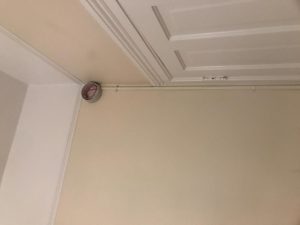Student Residents at Officers Circle Sign Petition After Security Cameras Were Installed Inside Their House
September 28, 2019
Students make dinner, study, spend hours talking about politics and watch Netflix together before turning in at Officer’s Circle. They also sign petitions together.
After discovering that security cameras were being installed inside of their houses — rather than on exterior of the unit —residents of Officer’s Circle quickly vocalized their concerns to Housing and Residential Education at the U.
Calls For Better Student Safety Soar
“The past couple of years, we’ve had events on campus,” said Erik Fronberg, referring to the shootings of Lauren McCluskey in October 2018 and ChenWei Guo in October 2017. “And they’re really close to where we live here.”
In the aftermath, campus safety concerns escalated after these incidents, and students demanded material answers, including transforming the U’s security infrastructure to better protect students.
Todd Justesen is the director of Residential Education at the U, and he said that the scale of some of these implementations was sparked by suggestions from students earlier this year at a U safety town hall. “We heard what are the three main concerns for students,” he said. “Putting cameras at every housing building, replacing thin windows … and requiring cards for entry access into buildings.”
Since then, the department has replaced windows vulnerable to break-ins and announced to all students living on campus in August about placing cameras, including the residents of Officer’s Circle.
Located by the Heritage Center, the historic, bone-colored houses were originally built for officers during the Civil War. It has remained a site for students invested in building a tightknit community within the home. To live in the OC, an additional application is required, and costs are higher than traditional residence halls.
Starting the Petition for Privacy
On Sept. 17, students at one Officer Circle’s house found out that the template of the cameras were constructed inside the living space. Then, on the day when the wires and outline of the camera position were planted on the wall, Fronberg and a housemate were compelled to stay up late and draft a petition. It articulates that they agree with the department’s goals to create a safer living environment campus, but they felt the decision to place the cameras in their homes impinged upon their privacy.
Fronberg says that isn’t the only issue at hand as well. “We’ve complained the door was broken and we felt unsafe that it didn’t completely lock,” said Fronberg, after his house reported it for over a year without any mention of repair by HRE.
“We got 20 signatures in the first two houses,” he said. “There was not a single person who was comfortable.” Fronberg sent the petition with 25 total lines to HRE shortly after.
‘The Intent Was Always to be Inside’
When HRE received the petition, Justesen says it’s understandable for OC students to be bothered by the cameras inside their living quarters. That’s why a camera’s angle will be positioned to only view the entrance of the door. “It will also only turn on when it detects movement [rather] than a continual video stream,” he said. The devices also won’t track audio inside the home, and will be only monitored by a security employee.

Justesen explains it was favorable to position the cameras inside because it detected faces easier. “You capture the entire face and figure coming in and out of the doorway,” he said. “Putting them outside makes it harder to see them clearly as they approach the door.”
Fronberg and his housemates were under the belief the cameras would be located outside, since their space feels more intimate than other resident halls. For HRE, Justesen says, the vision was always building them in the interior of OC’s homes.
Communication Begins, But Fronberg Still Plans to Stand
After submitting the open letter to HRE, Fronberg, alongside other OC residents, received an email response from the office. It outlined the points that Justesen had addressed regarding the cameras. They plan to continue with the interior lodging of the equipment. Much to the chagrin of Fronberg, on Sept. 25, the maintenance staff finished the camera system, and there are currently five cameras inside the house.
Fronberg says there is a possibility of the office for students hosting a town hall in order to air what is and isn’t working for them. “They haven’t announced it yet, ” he said. “But I did hear that from a couple of resident advisors.”
Fronberg, however, is pleased that HRE is willing to sustain a transparent and communication channel with him, his housemates and neighbors at Officer Circle. However, students still don’t know if HRE will ever meet their requests for an exterior placement for the cameras.
“HRE always wants to hear students’ concerns,” Justesen said. “We encourage this type of dialogue.”
For now, “Cameras are an important part of student safety,” Fronberg said. “But we also know that in the modern world, technology has certain ethical implications that need to be considered.”
An earlier version of this article said that in August, students were told cameras would be placed in their buildings. While students were told that cameras would be placed, they were not specifically told it would be in their building.








